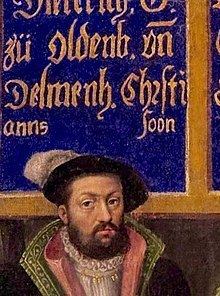Name Dietrich, of Role Prince | ||
 | ||
Predecessor Christian V of Oldenburg Mother Countess Agnes of Honstein Parents Christian V, Count of Oldenburg Spouse Helvig of Schauenburg (m. 1423), Countess Adelheid of Oldenburg-Delmenhorst, Children Christian I of Denmark, Gerhard VI, Count of Oldenburg Grandchildren Frederick I of Denmark, John, King of Denmark Similar People Christian I of Denmark, Frederick I of Denmark, Christian III of Denmark, Christian IV of Denmark, Frederick II of Denmark | ||
Derrick or Dietrich of Oldenburg, Latin-based Anglicisation also Theoderic of Oldenburg [1] (c. 1398 – 14 February 1440), nicknamed Theoderic the Lucky or the Fortunate (Teudericus Fortunatus), was a feudal lord in Northern Germany, holding the counties of Delmenhorst and Oldenburg. He was called "Fortunatus" as he was able to secure Delmenhorst for his branch of the Oldenburgs.
Contents

Dietrich was the father of Christian I of Denmark, a male-line ancestor to the present-day Danish throne under Margarethe II of Denmark as well as the last Czar of imperial Russia, Nicolas II. He is also the male line ancestor of Charles, Prince of Wales and Harald V of Norway.
Lineage
Dietrich of Oldenburg was the son of Christian V of Oldenburg (who became count in about 1398 and died in 1423) and his wife, Countess Agnes of Honstein (c. 1410–1460). His grandfather, Conrad I of Oldenburg (d. ca. 1368) had left his lands divided between Dietrich's father and uncle, Conrad II.
Dietrich’s father, Christian V, managed to gain the upper hand when Conrad II's son Maurice II died in 1420. After this, most of the Oldenburg family patrimony was under the power of Dietrich’s branch. However, the house had several minor branches that had estates and claims, as was usual in any medieval fief.
Dietrich of Oldenburg was the grandson of Ingeborg of Itzehoe, a Holstein princess who had married count Conrad I of Oldenburg. After the death of her only brother in 1350, Count Gerhard V of Holstein-Itzehoe-Plön, Ingeborg and her issue were the heirs of her own grandmother Ingeborg of Sweden (d. ca. 1290, first wife of Gerhard II of Holstein-Plön), the eldest daughter of King Valdemar of Sweden and Queen Sophia, who herself was the eldest daughter of the sonless King Eric IV of Denmark and his wife Jutta of Saxony. Since other legitimate descent from King Valdemar apparently was extinct by this time, Dietrich was considered the heir general of Kings Valdemar I of Sweden and Eric IV of Denmark.
Dietrich succeeded his father as head of the House of Oldenburg in 1423.
Marriages and children
Dietrich had first, as a child, married (for reasons of succession and uniting the hereditary fiefs) a distant cousin, Countess Adelheid of Oldenburg-Delmenhorst (who is said to have died already in 1404), daughter of Oldenburg Count Otto IV of Delmenhorst, and in 1423 he married for a second time, Helvig of Schauenburg (born in about 1398–1400, died 1436), widow of Prince Balthasar of Mecklenburg and daughter of the murdered Duke Gerhard VI of Schleswig-Holstein and his wife Elisabeth of Brunswick, thus sister of the reigning Duke Adolf VIII. All his legitimate children were born of the second wife.
His second marriage strengthened this interest in Scandinavian monarchies, since Helvig was a descendant of King Eric V of Denmark, King Haakon V of Norway and King Magnus I of Sweden.
At this time, all Scandinavia lived under the Kalmar Union erected by Queen Margarethe I of Denmark. In 1387 she had lost her own heir Olav IV of Norway, the new heirs now being Eric of Pomerania and his sister Catherine, who was married with a prince of the Palatinate and Bavaria.
Count Theodoric of Oldenburg is said to have been a rival claimant to the crowns of Sweden and Denmark during the reign of Eric VII/Eric XIII, whose succession was through Christopher I of Denmark, the younger brother of the murdered Eric IV, and through Magnus I of Sweden, younger brother of the deposed King Valdemar.
Count Theodoric had three surviving sons and one daughter:
Male line of descendants
Dietrich of Oldenburg is a direct ancestor to the Danish royal family and its derivatives, the British Royal Family, the pretenders to the Kingdom of the Hellenes, the Norwegian royal family, and the last Russian czars of Romanov-Holstein-Gottorp.
